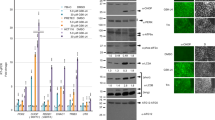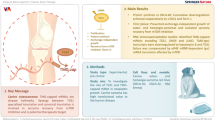Abstract
Gene-silencing activity mediated by siRNA has been demonstrated in mammalian cells; however, the mechanism of its regulation is not well understood. Since downregulation of a number of genes occurs during adenosine 3′,5′-cyclic monophosphate (cAMP)-induced differentiation of neuroblastoma (NB) cells, it is possible that cAMP may play a role in regulating siRNA activity during differentiation. To study this, we utilized an NB cell line (NBP2-PN25) that expresses a short-lived green fluorescent protein (d2EGFP) under the CMV promoter. These cells were transfected with a retroviral plasmid that expresses U6 promoter-driven expression of siRNA targeted to d2EGFP and then were treated with cAMP-elevating agents (200 μg/ml RO20-1724, an inhibitor of cyclic nucleotide phosphodiesterase, and 1 μg/ml prostaglandin A1, a stimulator of adenylate cyclase) for 2 or 24 h. The siRNA activity was measured by determining the level of intensity of d2EGFP protein by flow cytometry, and the level of d2EGFP mRNA by real-time PCR. The results showed that cAMP-elevating agents enhanced U6-driven siRNA activity directed towards d2EGFP in NB cells 24 h after treatment. One of the mechanisms of action of cAMP is mediated via phosphatidylinositol 3-kinase (PI3K) inhibition; therefore, we have investigated the effect of a PI3K inhibitor on siRNA activity. This study showed that inhibition of PI3K also enhanced U6-driven siRNA activity towards d2EGFP. cAMP-stimulating agents increased U6 transcript levels, perhaps suggesting that increased siRNA activity may in part be due to an increase in transcriptional activity. When NB cells were transfected with a synthetic siRNA directed to d2EGFP, both cAMP elevation and PI3K inhibition similarly enhanced siRNA activity. Sodium butyrate, which inhibits the growth of NB cells similar to the effect produced by cAMP, did not affect U6-driven siRNA activity towards d2EGFP. Protein kinase C (PKC) activation or inhibition also failed to affect siRNA activity in NB cells. This study also showed that cAMP elevation and PI3K inhibition increases U6-driven siRNA activity directed towards an endogenous gene, p53. Our data suggest a role for the cAMP pathway in affecting the efficacy of siRNA system during differentiation of NB cells.
This is a preview of subscription content, access via your institution
Access options
Subscribe to this journal
Receive 50 print issues and online access
$259.00 per year
only $5.18 per issue
Buy this article
- Purchase on Springer Link
- Instant access to full article PDF
Prices may be subject to local taxes which are calculated during checkout





Similar content being viewed by others
Abbreviations
- NB:
-
neuroblastoma
- cAMP:
-
adenosine 3′,5′-cyclic monophosphate
- PGA1:
-
prostaglandin A1
- RO20-1724:
-
4-3-butoxy-4-methoxybenzyl-2-imidazolidinone
- d2EGFP:
-
destabilized enhanced green fluorescent protein
- PI3K:
-
phosphatidylinositol 3-kinase
References
Bartel DP . (2004). Cell, 116, 281–297.
Castell X, Cheviron N, Barnier JV and Diebler MF . (2003). Neurochem. Res., 28, 557–564.
Elbashir SM, Harborth J, Lendeckel W, Yalcin A, Weber K and Tuschl T . (2001). Nature, 411, 494–498.
Grewal SI and Moazed D . (2003). Science, 301, 798–802.
Hannon GJ . (2002). Nature, 418, 244–251.
Hanson AJ, Prasad JE, Nahreini P, Andreatta C, Kumar B, Yan XD and Prasad KN . (2003). J. Neurosci. Res., 74, 148–159.
Khaled M, Larribere L, Bille K, Ortonne JP, Ballotti R and Bertolotto C . (2003). Pigment Cell Res., 16, 573.
Krichevsky AM and Kosik KS . (2002). Proc. Natl. Acad. Sci. USA, 99, 11926–11929.
Lee HT and Kay EP . (2003). Invest. Ophthalmol. Vis. Sci., 44, 3816–3825.
Morris KV, Chan SW, Jacobsen SE and Looney DJ . (2004). Science, 305, 1289–1292.
Nahreini P, Andreatta C and Prasad KN . (2001a). Cell. Mol. Neurobiol., 21, 509–521.
Nahreini P, Hovland AR, Kumar B, Andreatta C, Edwards-Prasad J and Prasad KN . (2001b). Cell. Mol. Neurobiol., 21, 65–79.
Pfaffl MW, Horgan GW and Dempfle L . (2002). Nucleic Acids Res., 30, e36.
Pickford AS and Cogoni C . (2003). Cell Mol. Life Sci., 60, 871–882.
Poser S, Impey S, Xia Z and Storm DR . (2003). J. Neurosci., 23, 4420–4427.
Prasad KN . (1980). Life Sci., 27, 1351–1358.
Prasad KN . (1991). Biol. Rev. Camb. Philos. Soc., 66, 431–451.
Prasad KN and Sinha PK . (1976). In vitro , 12, 125–132.
Takei Y, Kadomatsu K, Yuzawa Y, Matsuo S and Muramatsu T . (2004). Cancer Res., 64, 3365–3370.
Tijsterman M, Ketting RF and Plasterk RH . (2002). Annu. Rev. Genet., 36, 489–519.
Yan XD, Hanson AJ, Nahreini P, Koustas WT, Andreatta C and Prasad KN . (2002). In vitro Cell Dev. Biol. Anim., 38, 529–537.
Acknowledgements
We thank Karen Helm and Michael Ashton and the UCHSC Flow Cytometry Core Facility for their assistance with this study. This work was supported by National Institutes of Health grant numbers RO1 AG18285 and RO1 NS38647.
Author information
Authors and Affiliations
Corresponding author
Rights and permissions
About this article
Cite this article
Hanson, A., Nahreini, P., Andreatta, C. et al. Role of the adenosine 3′,5′-cyclic monophosphate (cAMP) in enhancing the efficacy of siRNA-mediated gene silencing in neuroblastoma cells. Oncogene 24, 4149–4154 (2005). https://doi.org/10.1038/sj.onc.1208577
Received:
Revised:
Accepted:
Published:
Issue Date:
DOI: https://doi.org/10.1038/sj.onc.1208577



